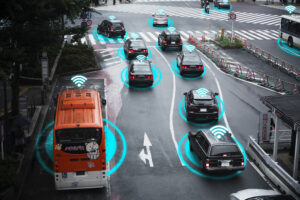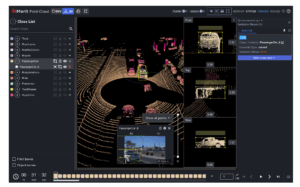Training perception systems for autonomous vehicles, robotics, and drones requires more than just labeling images or point clouds in isolation. Multi-sensor fusion annotation—combining data from LiDAR, radar, RGB cameras, IMUs, and more- requires sophisticated platforms that handle time-synced streams, sensor calibration, and 3D visualization.
In this guide, we explore the top tools purpose-built to annotate complex, multi-modal sensor data. These platforms offer everything from fused 3D viewers to ML-assisted workflows, helping you accelerate training data creation while maintaining precision.

Here are the Top 7 tools for multi-sensor fusion annotation in 2025.
1. Ango Hub by iMerit — Designed for Multimodal Sensor Precision
Ango Hub is one of the few platforms purpose-built for real-world autonomous mobility workflows, where multi-sensor data is the norm. Whether it’s LiDAR-camera fusion, radar overlays, or GPS-aligned trajectory labeling, Ango Hub provides a robust framework for managing and annotating fused datasets.
Key Features:
- Synchronized Multi-Stream Playback: Align LiDAR, RGB camera, radar, and GPS streams with time-coded precision.
- Sensor-Aware Annotation Tools: Label directly in fused views or individually by stream, with real-time updates across modalities.
- Advanced Calibration Support: Visualize and correct sensor offsets, ensuring geometric alignment for accurate labeling.
- Custom Ontologies per Sensor: Define and apply taxonomies specific to each modality or task (e.g., depth objects, motion trails, pedestrian classes).
- QA at Fusion Level: Built-in expert review of fusion accuracy, annotation consistency, and frame continuity.
- Secure, Scalable Deployment: On-premise, hybrid, or cloud deployments tailored to compliance-heavy AV and robotics teams.
- Automation for Sensor Fusion Workflows: Tools for temporal alignment, sensor-aware pre-labeling, and annotation propagation streamline high-complexity pipelines
- API Integration and Developer Controls: Fusion-aware APIs for pipeline automation, validation workflows, and metadata management

Why It Stands Out:
Ango Hub combines technical excellence with human-in-the-loop (HITL) services, ensuring that annotations are not only sensor-accurate but also semantically aligned with real-world driving edge cases. It’s an ideal solution for AV companies looking to go beyond object-level labeling and move toward behavioral and contextual understanding across sensors.
2. Deepen AI – Calibration-aware labeling for advanced AV systems
Deepen AI offers a sensor fusion platform with a strong emphasis on calibration. Its suite includes tools for camera-LiDAR-radar alignment, 3D bounding boxes, segmentation, and time-synced labeling. Designed for automotive-grade projects, it also supports on-prem deployments and regulatory compliance needs.
Key Features:
- LiDAR-camera-radar calibration toolkit
- Frame synchronization and temporal labeling
- Side-by-side and overlay fusion views
- 3D/2D bounding box and segmentation tools
- Time-synced multi-sensor workflows
- On-prem and compliant deployments for AV
- 3D annotation across modalities
Deepen AI is well-suited for AV teams with advanced data pipelines that need a high level of calibration control and quality assurance.
3. AWS SageMaker Ground Truth – Scalable Labeling in AWS Ecosystem
SageMaker Ground Truth supports camera and LiDAR data annotation with tools to manage large datasets across distributed teams.
Key Features:
- Native support for 3D cuboid labeling on LiDAR point clouds
- Sensor fusion labeling capabilities via AWS RoboMaker
- Integration with Amazon S3, SageMaker training jobs, and Ground Truth Plus
- Pre-labeling and active learning workflows
Best if a team is already fully embedded in AWS cloud infrastructure.
4. CVAT – Open-Source Support for Fusion Annotation
CVAT (Computer Vision Annotation Tool) is a widely used open-source platform from Intel. While not designed explicitly for sensor fusion, it offers plugins and extensions that support basic fusion workflows.
Key Features:
- Support for 2D/3D annotation via extensions
- Community plugins for LiDAR and radar data
- Custom label schemas and API integration
- Lightweight for academic or early development use
Ideal for smaller teams or research labs looking for flexible, cost-effective tooling.
5. Scale AI – Fusion-First Enterprise Labeling
Scale AI powers fusion pipelines for some of the biggest AV companies. With support for synchronized LiDAR–camera annotation, built-in QA dashboards, and seamless automation, it’s designed for production-scale deployments. Now enhanced by its acquisition of Segment.ai, Scale supports developer-centric, multi-sensor workflows with added flexibility and automation.
Key Features:
- Fusion of LiDAR, radar, RGB, and thermal data
- Custom pipelines with QA workflows
- Model-assisted labeling and active learning
- Task types include 3D cuboids, segmentation, and classification
For high-volume AV projects needing programmatic scaling with automation in the loop.
6. Kognic: Safety-Critical Sensor Fusion Workflows
Kognic specializes in sensor fusion annotation for ADAS and autonomous vehicles, offering tools tailored to meet stringent safety, quality, and validation needs. With a focus on precise calibration and high configurability, it’s ideal for enterprise-grade automotive AI pipelines.
Key Features:
- Sensor fusion support with 3D LiDAR, radar, and camera inputs
- Customizable QA pipelines and ontologies
- Tools for ground truth management and scenario coverage
- Built-in compliance features for ISO 26262 and ASIL alignment
- Collaboration features for human-in-the-loop review and feedback
For teams managing cross-functional annotation pipelines with a focus on speed and quality.
7. SuperAnnotate: Collaborative Annotation for Complex Multi-modal Data
SuperAnnotate is a robust end-to-end data annotation platform designed to handle diverse modalities, including LiDAR, video, and image data. Its emphasis on automation, collaboration, and quality control makes it a solid choice for teams managing multi-sensor fusion projects at scale.
Key Features:
- Multi-modal support for LiDAR, video, and images
- AI-assisted pre-labeling and model integration workflows
- Advanced collaboration tools with role-based access
- Built-in quality management and plugin ecosystem
For teams working on high-stakes, regulation-heavy AI systems requiring rigorous quality control.
Final Thoughts: Fusion Demands Focus
As perception systems evolve, sensor fusion is no longer optional; it’s the backbone of robust AV performance. But annotation platforms must keep up with this complexity, offering precision syncing, multimodal tools, and real-time QA to ensure model reliability.
Ango Hub leads the pack by going beyond basic toolsets. With its fusion-native architecture, human-in-the-loop QA, and real-world deployment flexibility, it’s a trusted partner for teams building the next generation of autonomous systems.
